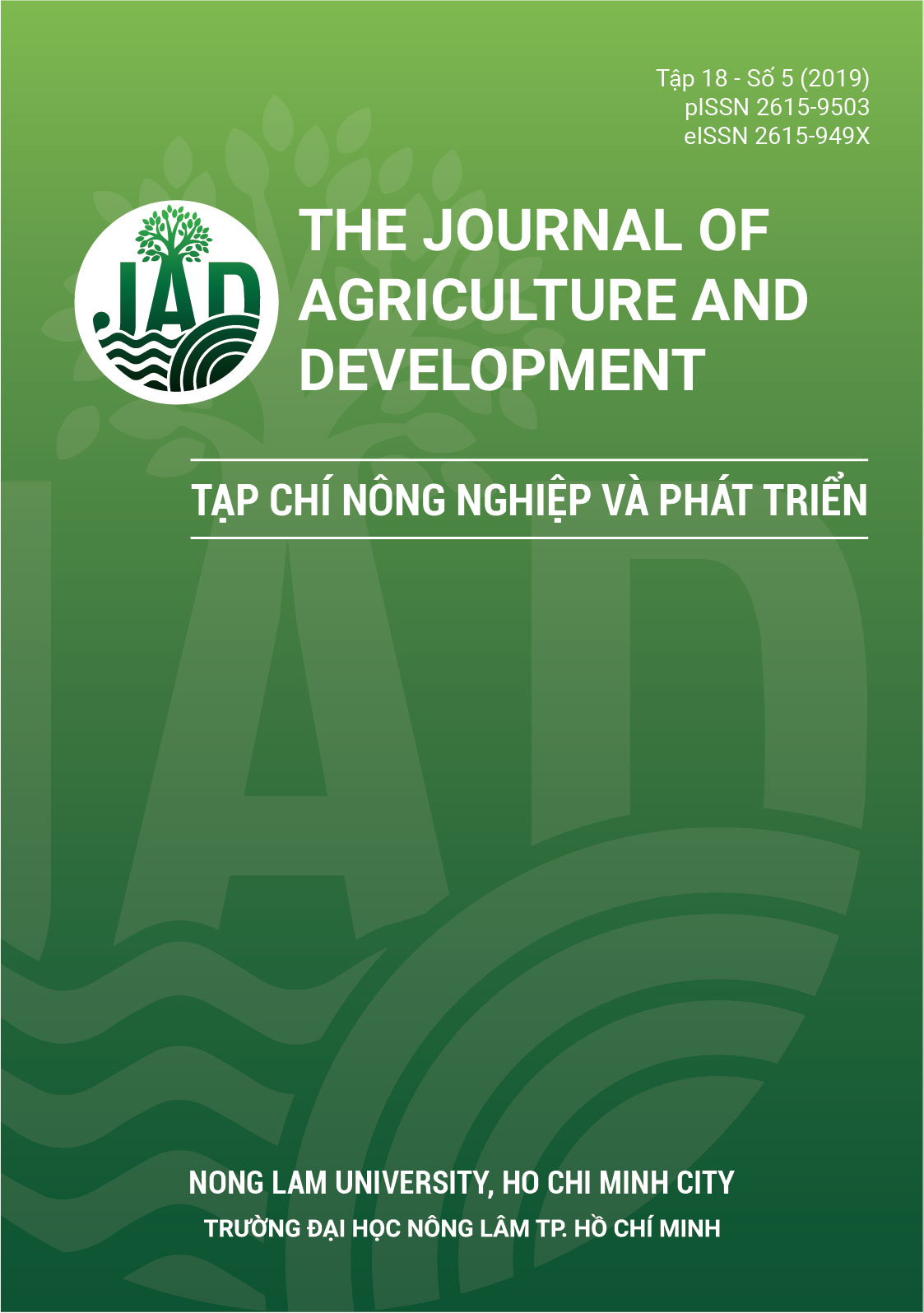Evaluation of chemical composition and inhibitory effects of Hypochaeris radicata L. extracts on seed germination and growth of Echinochloa crus-galli L.
Main Article Content
Abstract
Allelopathy is a common plant-resistance mechanism in nature, this mechanism demonstrates the growth of this plant that may affect the growth and development of other nearby plant species through the production of secondary compounds. In this study, the allelopathic ability of ethanol extracts from Hypochaeris radicata L. on Echinochloa crus-galli L. was investigated in laboratory conditions. The extracts from stems of Hypochaeris radicata L. at the concentration of 5 mg/mL showed highest inhibition (73.33%) on seed germination of barnyard-grass (Echinochloa crus-galli L.). In this study, total polyphenol and flavonoids in Hypochaeris radicata L. were determined by spectrophotometry. Polyphenol and flavonoids present in all parts of the Hypochaeris radicata L. were investigated. The highest polyphenol content in leaves was 9.67 mg/g extract and the flavonoid content in roots was 29.56 mg/g extract. Phenolic acids in extracts from leaves, flowers, and roots were identified by HPLC. The results showed the presence of 7 phenolic acids including chlorogenic, syringic, vanillic, synapic, p-coumaric, benzoic and ellagic in the extracts. The findings highlighted that Hypochaeris radicata L. is a wild plant species with great potential for allelochemicals.
Article Details
References
Abu-Romman, S. (2016). Differential allelopathic expression of different plant parts of Achillea biebersteinii. Acta Biologica Hungarica 67(2), 159-168. https://doi.org/10.1556/018.67.2016.2.4
Balicevic, R., & Ravlic, M. (2015). Allelopathic effect of scentless mayweed extracts on carrot. Herbologia 15(1), 11-18. https://doi.org/10.5644/Herb.15.1.02
Cameron, H. J., & Julian, G. R. (1980). Inhibition of protein synthesis in lettuce (Latuca sativa L.) by allelopathic compounds. Journal of Chemical Ecology 6(6), 989-995. https://doi.org/10.1007/BF00994656
Chung, I. M., Kim, J. T., & Kim, S. H. (2006). Evaluation of allelopathic potential and quantification of momilactone A, B from rice hull extracts and assessment of inhibitory bioactivity on paddy field weeds. Journal of Agricultural and Food Chemistry 54(7), 2527-2536. https://doi.org/10.1021/jf052796x
Dewanto, V., Wu, X., Adom, K. K., & Liu, R. H. (2002). Thermal processing enhances the nutritional value of tomatoes by increasing total antioxidant activity. Journal of Agricultural and Food Chemistry 50(10), 3010-3014. https://doi.org/10.1021/jf0115589
Ilori, O. J., Otusanya, O. O., Adelusi, A. A., & Sanni, R. O. (2010). Allelopathic activities of some weeds in the Asteraceae family. International Journal of Botany 6(2), 161-163. https://doi.org/10.3923/ijb.2010.161.163
Jabran, K. (2017). Manipulation of allelopathic crops for weed control. Springer briefs in plant science Switzerland. Berlin, Germany: Springer.
Khang, D. T., Anh, L. H., Ha, P. T. T., Tuyen, P. T., Quan N. V., Minh, L. T., Quan N.T., Minh, T. N., Xuan, T.D., Khanh, T. D., & Trung, K. H. (2016). Allelopathic activity of dehulled rice and its allelochemicals on weed germination. International Letters of Natural Sciences 58(2), 1-10. https://doi.org/10.18052/www.scipress.com/ILNS.58.1
Kim, O. Y., Park, S. I., Jung, I. M., & Ha, S. Y. (2005). The allelopathic effects of aqueous extracts of Hypochaeris radicata L. on forage crops. Journal of Life Science 15(6), 871-878. https://doi.org/10.5352/JLS.2005.15.6.871
Li, Z. H., Qiang, W., Ruan, X., Pan, C. D., & Jiang, D. A. (2010). Phenolics and plant allelopathy. Molecules 15, 8933-8952. https://doi.org/10.3390/molecules15128933
Pejman, N., Hassan, K., Morteza, M., & Nayereh, A. S. H. (2011). Allelopathic potential of sunflower on weed management in safflower and wheat. Australian Journal of Crop Science 5(11), 1434-1440.
Thi, H. L., Lin, C. H., Smeda, R. J., Leigh, N. D., Wycoff, W. G., & Fritschi, F. B. (2014). Isolation and identification of an allelopathic phenylethylamine in rice. Phytochemistry 108, 109-121. https://doi.org/10.1016/j.phytochem.2014.08.019
Wang, R. L., Liu, S. W., Xin, X. W., Chen, S., Peng, G. X., Su, Y. J., & Song, Z. K. (2017). Phenolic acids contents and allelopathic potential of 10-cultivars of Alfalfa and their bioactivity. Allelopathy Journal 40(1), 63-70.
Weston, L. A., & Mathesius, U. (2013). Flavonoids: their structure, biosynthesis and role in the rhizosphere, including allelopathy. Journal of Chemical Ecology 39(2), 283-297. https://doi.org/10.1007/s10886-013-0248-5
Xuan, T. D., Tsuzuki, E., Terao, H., Matsuo, M., Khanh, T. D., Murayama, S., & Hong, N. H. (2003). Alfalfa, rice by-products and their incorporation for weed control in rice. Weed Biology and Management 3(2), 137-144. https://doi.org/10.1046/j.1445-6664.2003.00095.x
Zhishen, J., Mengcheng, T., & Jianming, W. (1999). The determination of flavonoid contents in mulberry and their scavenging effects on superoxide radicals. Food Chemistry 64(4), 555-559. https://doi.org/10.1016/S0308-8146(98)00102-2








